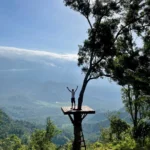Ever since learning about the Holocaust in high school, visiting Auschwitz has always been something I wanted to do. Good Friday and Easter Monday are national holidays here in Germany, so since I have a four-day weekend I decide to go to Poland and visit Auschwitz (Good Friday also happens to fall on my birthday this year). It isn't until after I book my tickets that I learn Easter is one of the biggest and most important holidays in Poland.
Germany to Kraków, Poland
Thursday
Well rested, backpack packed, and ready for a fun weekend, I take the 15-minute tram ride to the central bus station to catch my first FlixBus to Berlin. In Berlin, I have about an hour before my next bus, so since the weather is finally nice, I soak in some vitamin D like many others are doing. I board the next and final bus to Kraków. When crossing over from Germany to Poland the road becomes noticeably rougher which reminds me of driving from Ohio or Indiana into Michigan. However, it is just a short section of roughness and the road quickly becomes better. Along the way, there is some kind of backup on the expressway so the bus driver exits and takes back roads to bypass the traffic. While it is making the trip a little longer, I'm grateful for the detour. We pass beautiful villages, farms, churches, people riding bikes, etc. which provide a glimpse into the everyday lives of the Polish.
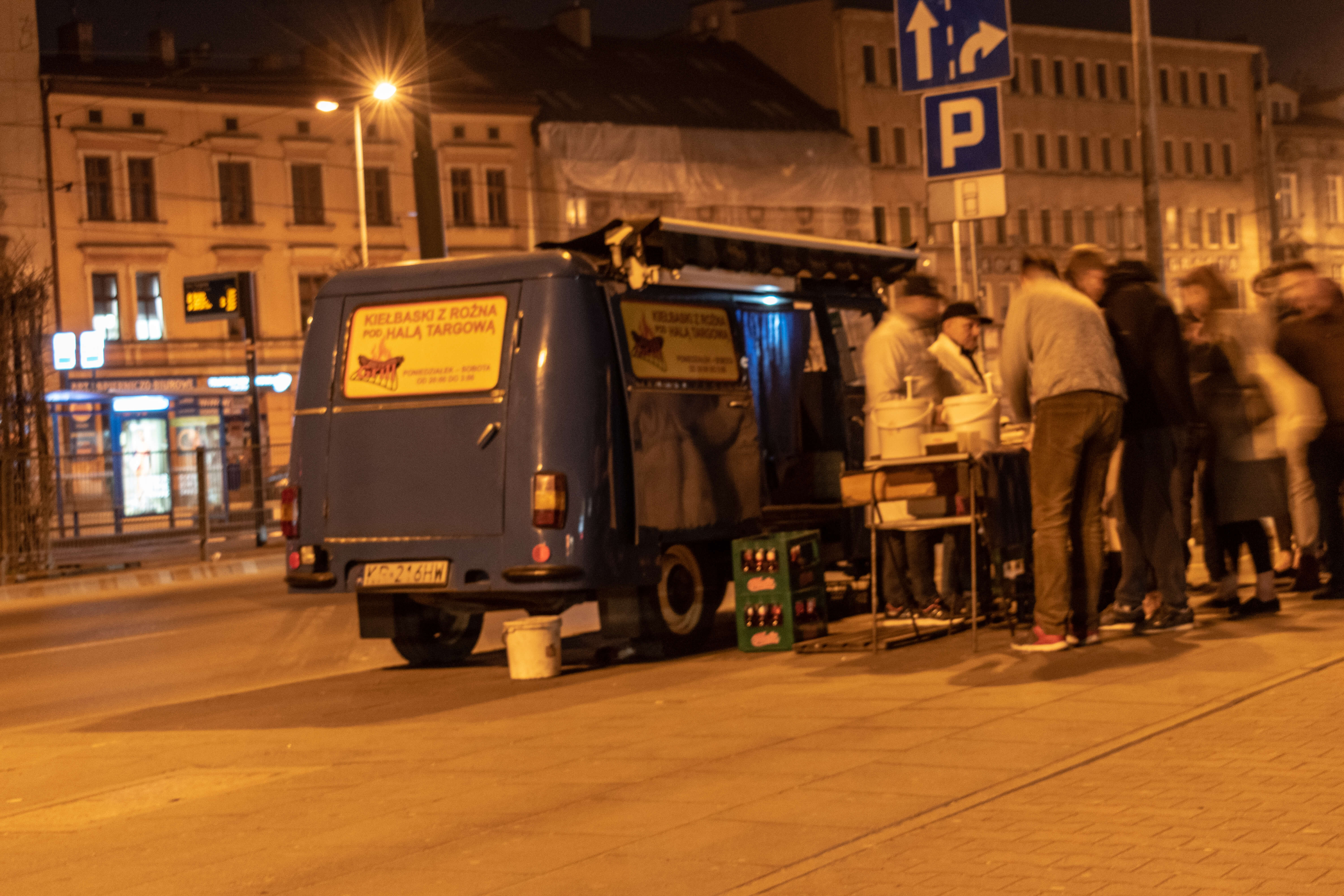 At 9 pm and after nearly nine hours, we pull into Kraków bus station. I exit the station into the cool, crisp night and begin the short walk through the cobblestone streets to the hostel. After 12 hours of traveling, I’m hungry! I love food and Poland and Kraków are a foodie's paradise. Prior to my trip, I researched what food I needed to try and planned out my meals because, since it's Easter weekend, many businesses are closed or have different hours. Tonight’s dinner is kielbasa at Kiełbaski z Niebieskiej Nyski. This is a famous food "truck" located on Grzegórzecka street, open nightly from 8 pm to 3 am (excluding Sundays). Two guys wearing white smocks stand outside of their blue Nyska (Soviet model van) grilling kielbasa. I get in line behind about 20 people and eventually eat some mouth-watering kielbasa and a roll before calling it a night.
At 9 pm and after nearly nine hours, we pull into Kraków bus station. I exit the station into the cool, crisp night and begin the short walk through the cobblestone streets to the hostel. After 12 hours of traveling, I’m hungry! I love food and Poland and Kraków are a foodie's paradise. Prior to my trip, I researched what food I needed to try and planned out my meals because, since it's Easter weekend, many businesses are closed or have different hours. Tonight’s dinner is kielbasa at Kiełbaski z Niebieskiej Nyski. This is a famous food "truck" located on Grzegórzecka street, open nightly from 8 pm to 3 am (excluding Sundays). Two guys wearing white smocks stand outside of their blue Nyska (Soviet model van) grilling kielbasa. I get in line behind about 20 people and eventually eat some mouth-watering kielbasa and a roll before calling it a night.
Auschwitz I


Friday
I awake at 4 am, get ready, and take the short walk to the main square to leave for Auschwitz. After an hour drive from Kraków to Oświęcim, we pull into Auschwitz. It's early in the morning so there is still fog in the air. After passing through the security checkpoint, the tour begins. The first stop is the infamous "Arbeit macht frei" sign (Work sets you free). It is at this point where it really sets in for me where I am. Thousands of people walked under this sign and became prisoners, victims.
Next, we walk through several buildings that have been turned into exhibitions. From photos to documents and personal belongings to living conditions, these exhibitions give just a glimpse into the atrocities that occurred here. Some of the hardest things to see are: the empty gas cans used to kill thousands, rooms full of the victims shoes (especially the children's shoes), the pictures and names of victims, and the rooms full of the hair that was shaven off of the prisoners (no pictures allowed of the hair). In one of the basements, we get a look into the "living" conditions in some cells. It's dark, cramped, and cold. Some of the cells are just big enough to sit and prisoners had to crawl just to get in and out of them.

We walk past the Death Wall where thousands were executed on our walk to one of the gas chambers. Aside from the chimney rising from the top of the "hill", from the outside the gas chamber just looks like a hill. The inside shows otherwise. I walk through the door into a wide open, dark room. It is here where thousands of innocent people were murdered. As I look up at the ceiling, I see one of the holes where the cans full of poison gas were dropped into the chambers full of people. I can't imagine what it was like. I and the others had a way out. We could exit through the doors. This wasn't the case for the victims. They were stripped naked, crammed into the room, and the doors were sealed shut. There was no way out. As graphic as it may be, the tour guide describes what it looked like inside after everyone was deceased. There weren't bodies spread all over the room. Instead, it was "like a pyramid of bodies". The victims were all found in a pile near the door where they had tried to escape. They also tried to get as high as possible as the gas spread from the floor to the ceiling. The guide also informs us that the gas chambers were repurposed and used as bunkers during the war. They went from murdering innocent people inside to using them for the war. In the next room is the crematorium where the victims' bodies were moved on carts in the floor and eventually burned.
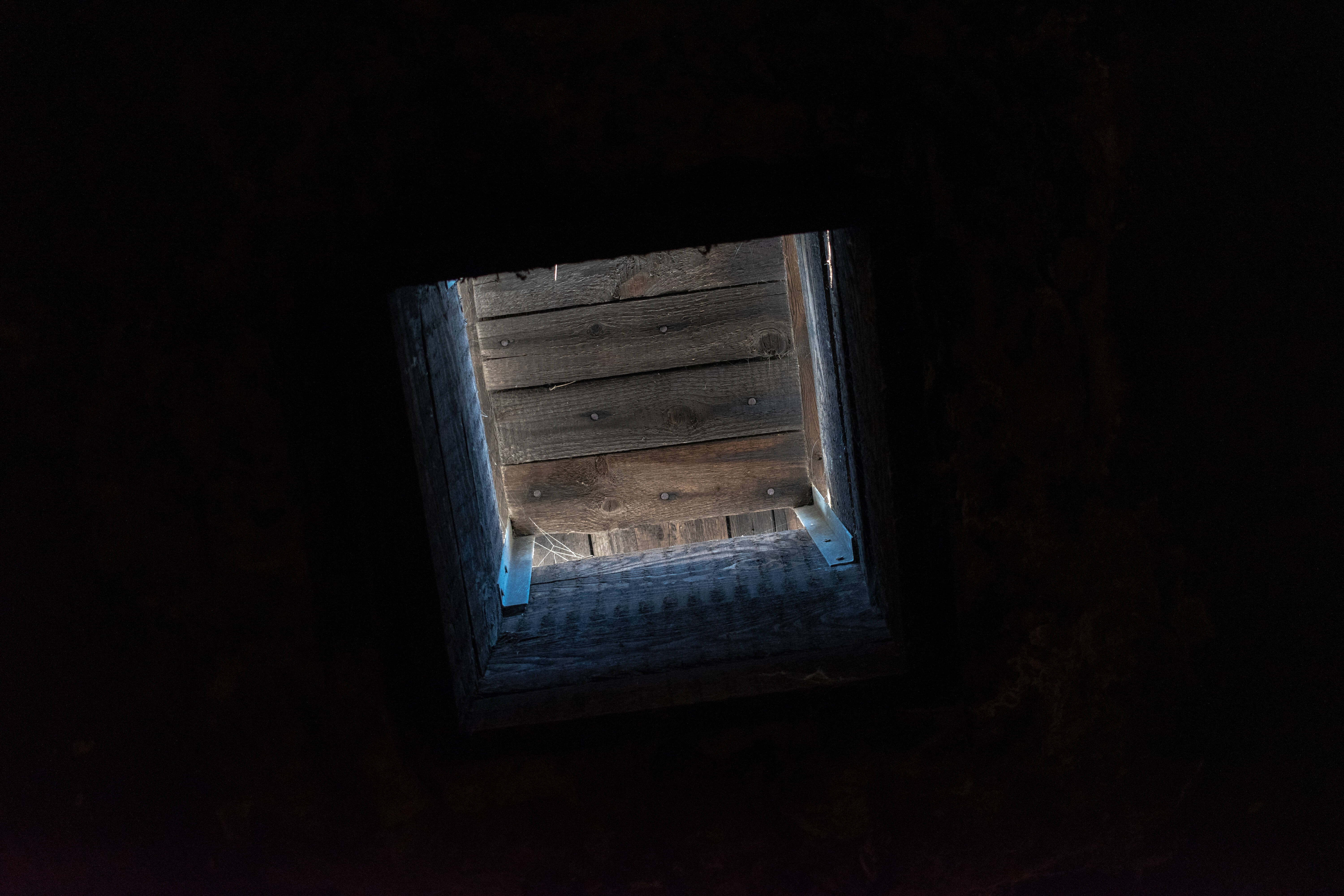
Auschwitz II - Birkenau
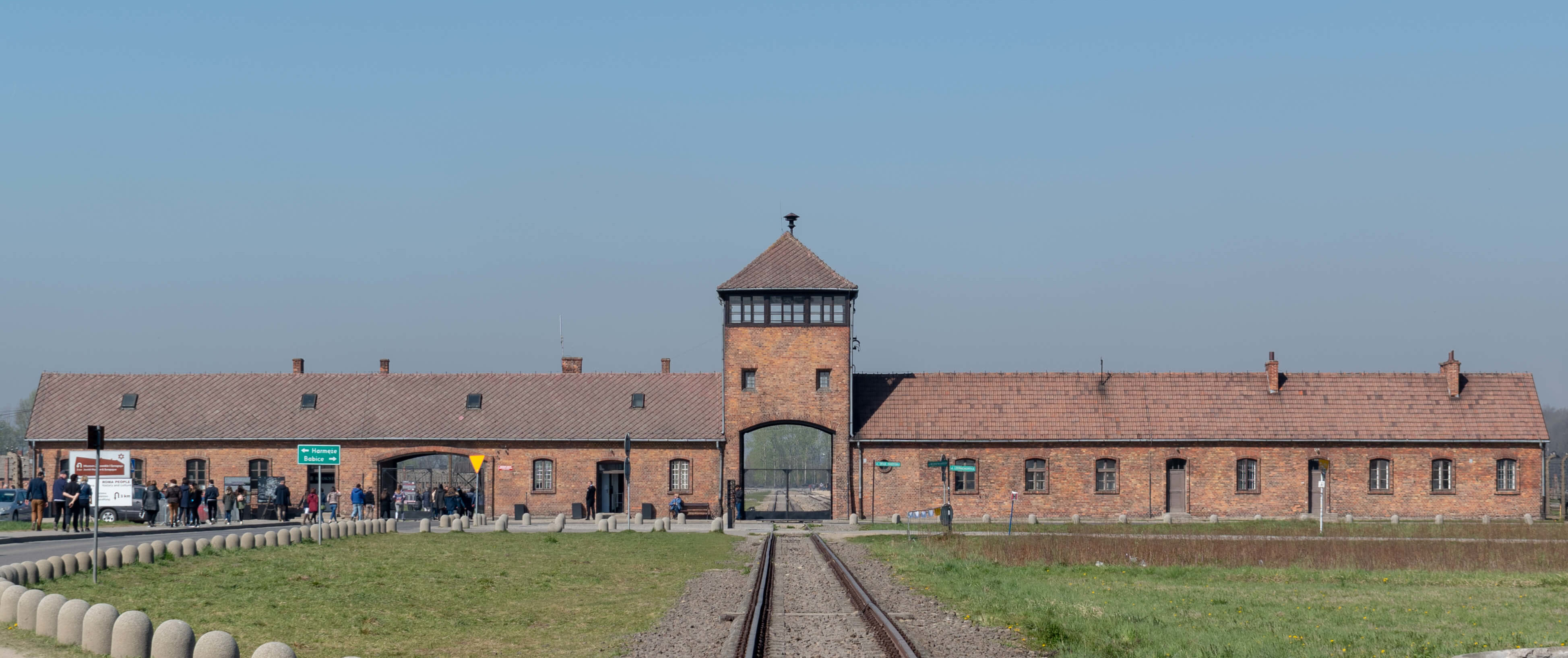
Three kilometers away from Auschwitz I is Auschwitz II - Birkenau. Auschwitz I held a lot of the administration buildings and the very first prisoners. Auschwitz II - Birkenau was built later and was basically a murder factory. A trip or transfer to Birkenau was almost certainly a death sentence. As I approach, the infamous entrance (called the "Gate of Death" by prisoners) looms closer and closer. Auschwitz II - Birkenau feels very different from Auschwitz I. The mere size and expanse of Birkenau is incredible (it's smaller today than it was pre-war). When the camp first opened in October of 1941, there were no train tracks through the gate. It wasn't until spring of 1944 that the tracks were added. Shortly after, Hungarian Jews were brought in day and night in trains of 40 to 50 cars. At the peak of the Hungarian Jew deportation, during a single ten-week period, nearly 12,000 Jews were gassed and burned each day. Each day! Following the tracks, I make my way towards "the ramp" where the Jews would exit the trains and the selection process would occur. It is here where men and women, strong and weak were separated into different lines. Those determined strong enough for manual labor were allowed to live (at least temporarily) while the others were sent directly to one of the four gas chambers.
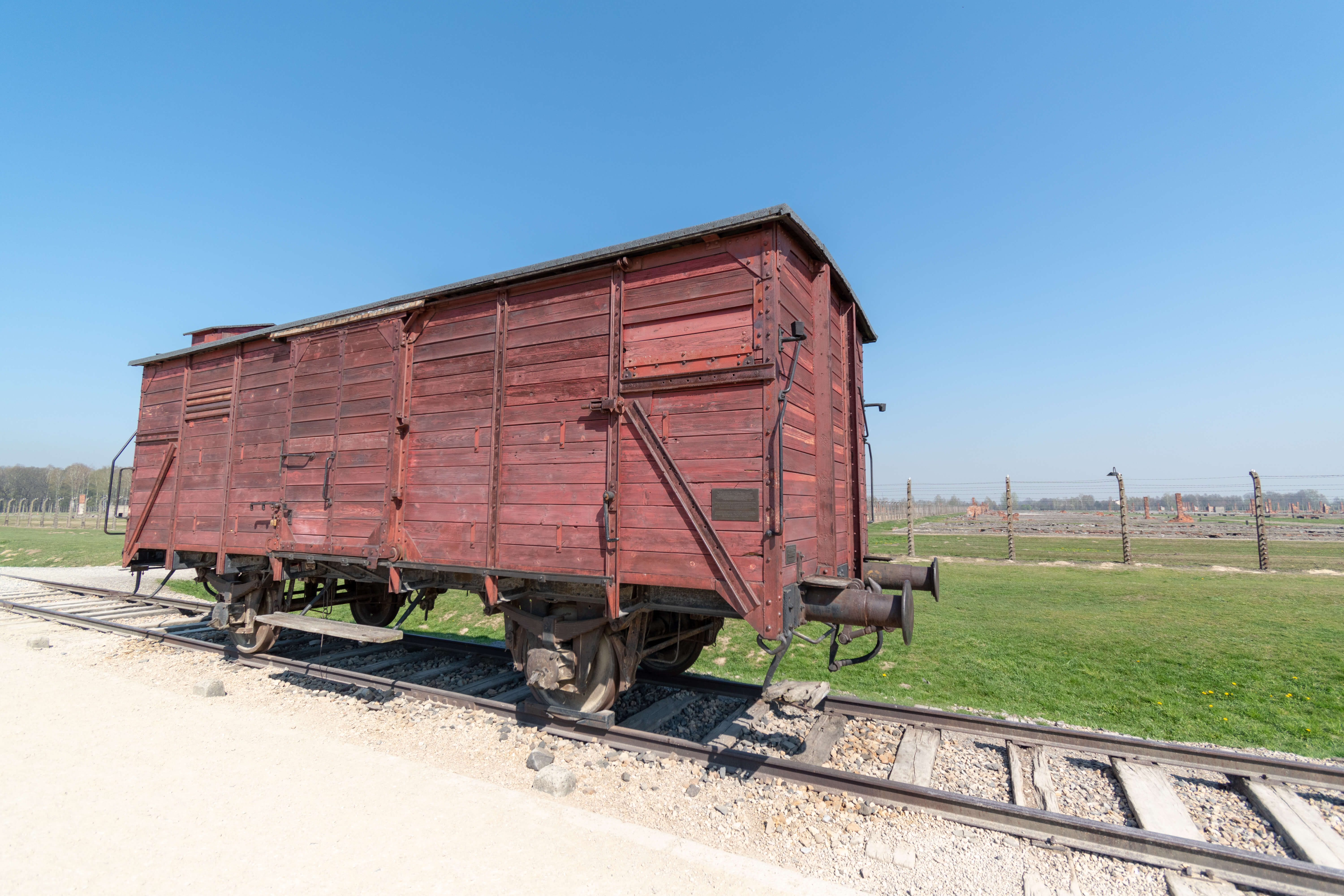
I think, for me, the most harrowing thing to see at Birkenau is the barracks. Before entering, the guide shows us how the lower bricks are discolored. This is from the early years of Birkenau when flooding was an issue. Even with the flooding, hundreds of people were forced to live in horrible conditions. Inside the barracks, you find triple bunks (the bottom being on the ground) where five to seven people would live on each bunk. With such tight confines and lack of infrastructure, diseases spread rapidly and killed those who were initially deemed fit.
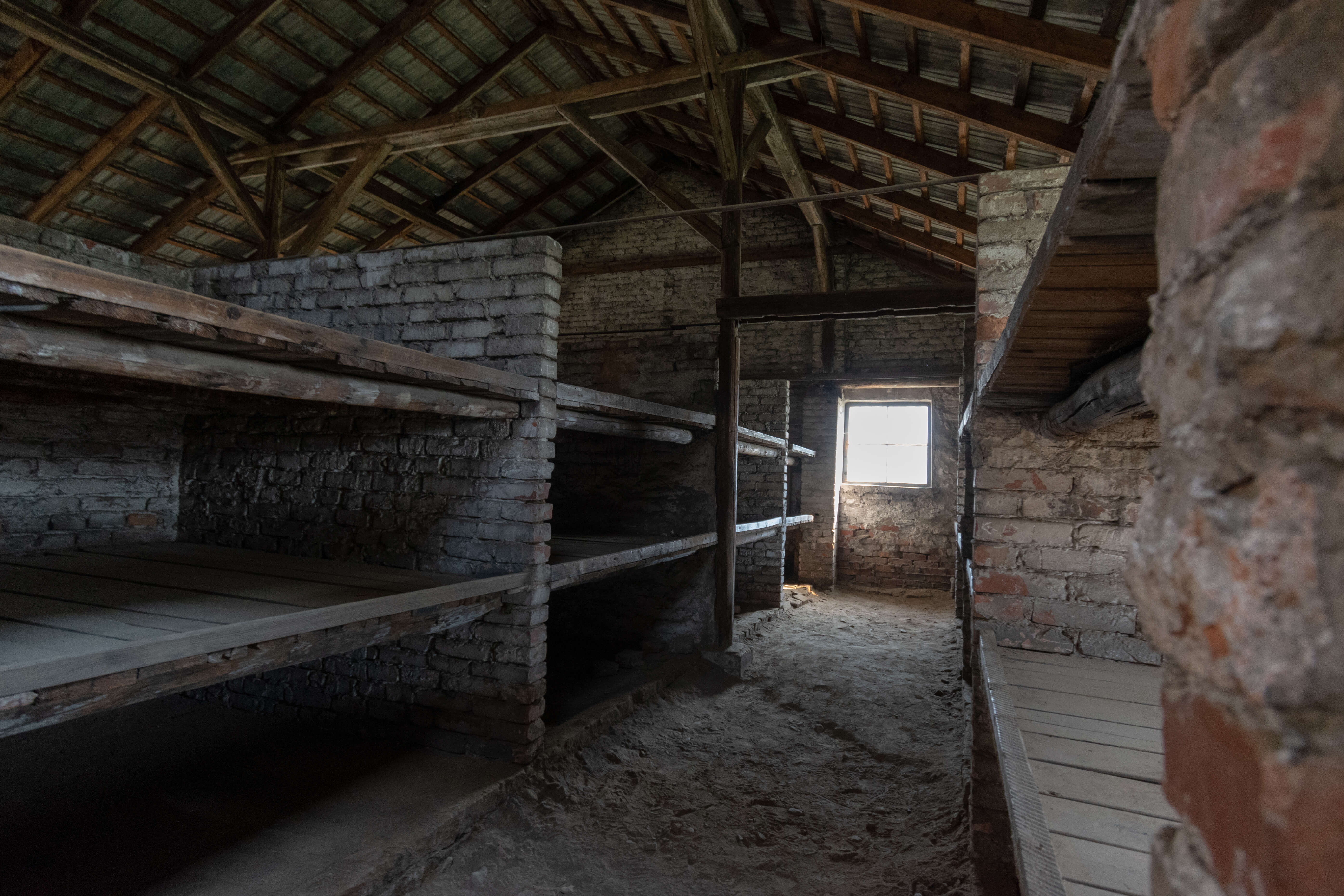
Thoughts on Auschwitz I & Auschwitz II - Birkenau
While I wish such a place didn't exist, I am glad I had the opportunity to visit. Learning about it in school and watching movies about it is one thing but seeing it in person just makes it that much more real. If you are ever in Poland or Europe, I highly recommend visiting.
Kraków & Easter Market
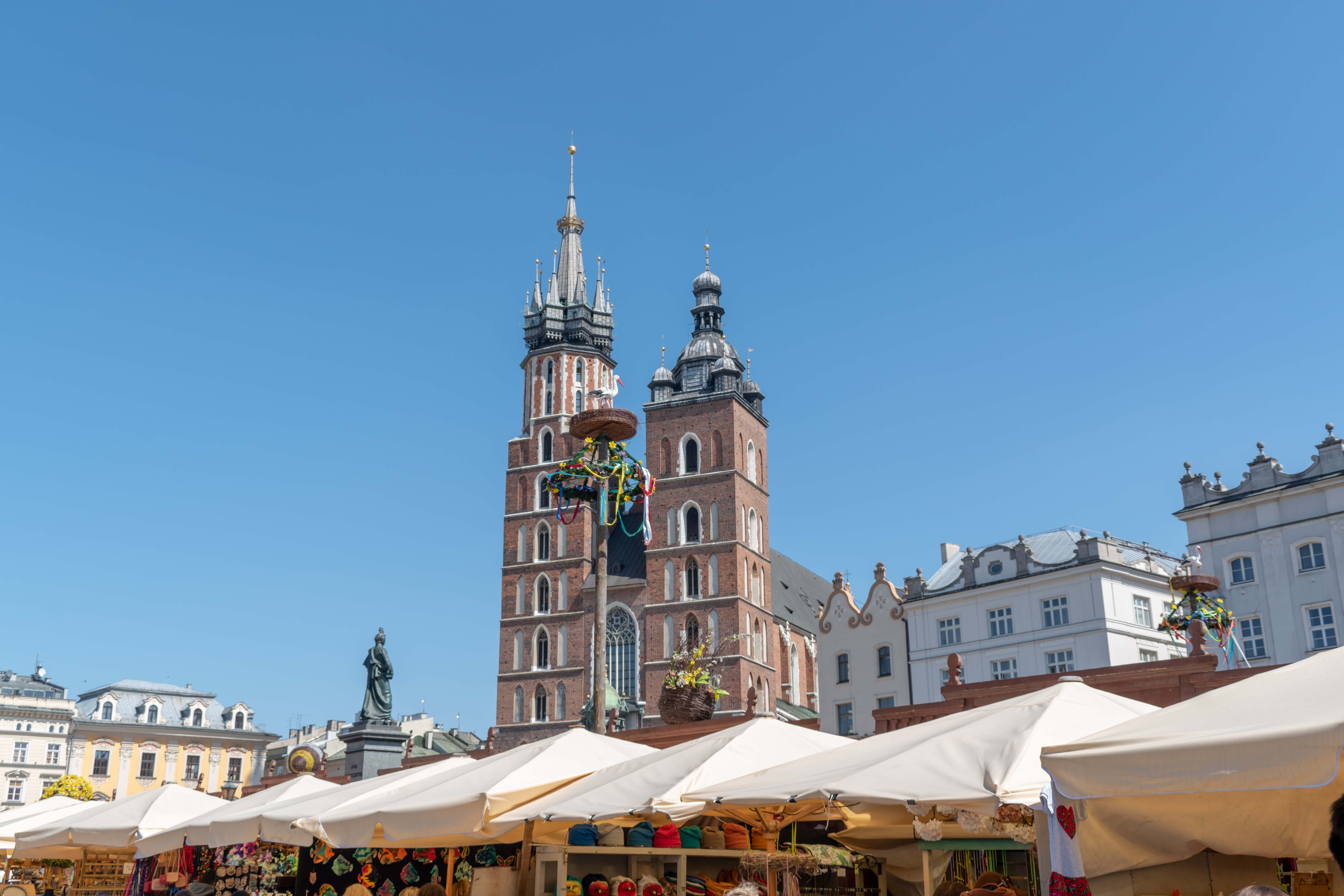
It’s now midday when we arrive back in Kraków and I’m going to explore the Easter market which is in Kraków's main square, Rynek Główny. In the past, Rynek Główny has been voted the best "square" in the world and I can see why. The square is large and busy yet charming and quiet and has a lot to offer. Add in the Easter market and it's simply breathtaking. For Easter, the square is decorated with a lot of flowers, eggs, wooden stalls, etc.
As you walk around the market, the aromas are sure to make your taste buds water. Pierogi, kielbasa, vegetables, chocolate, ice cream, waffles, lemonade, beer, bread, etc. It can all be found here. After looking at all my options for a snack, I decide on a shish kebab and potatoes which are quite tasty. If you're looking to buy something, there are a plethora of options. Flowers, hand-painted wooden eggs, jewelry, toys, woven Easter baskets, etc. As I walk around the market I take in the smells and the craftsmanship of the local vendors.

Horse-drawn carriages are passing by me as I walk the cobblestone streets towards Wawel Castle. The horse-drawn carriages depart from the main square and go to Wawel Hill and the Jewish Quarter. The horses are beautiful! While I'm walking, the sound of an accordion catches my ear. I look across the street to see a young boy playing the accordion. He has the biggest smile on his face as he plays for everyone passing by. I explore the castle’s grounds and take in the views of the city before heading to dinner. I read that Prystanek Pierogarnia has some of the best pierogi so I’ve decided to give it a try. I can't decide on which kind to get so I get the variety which has ten different types. Each one had a unique taste, but all were very tasty.
As I head back to the castle, the sun is beginning to set. I climb the grass hill to the base of the castle wall to relax and watch the sunset over the river. Along the river is a path where Cracovians (people from Kraków) are constantly running, biking, skateboarding, rollerblading, scootering, etc. The sun has fallen into the horizon and I walk back through the market on my way to see it at night. Besides the lights, not much has changed. It is still bustling with people enjoying themselves. It’s been a long day and I’m ready to get some rest to explore more tomorrow.
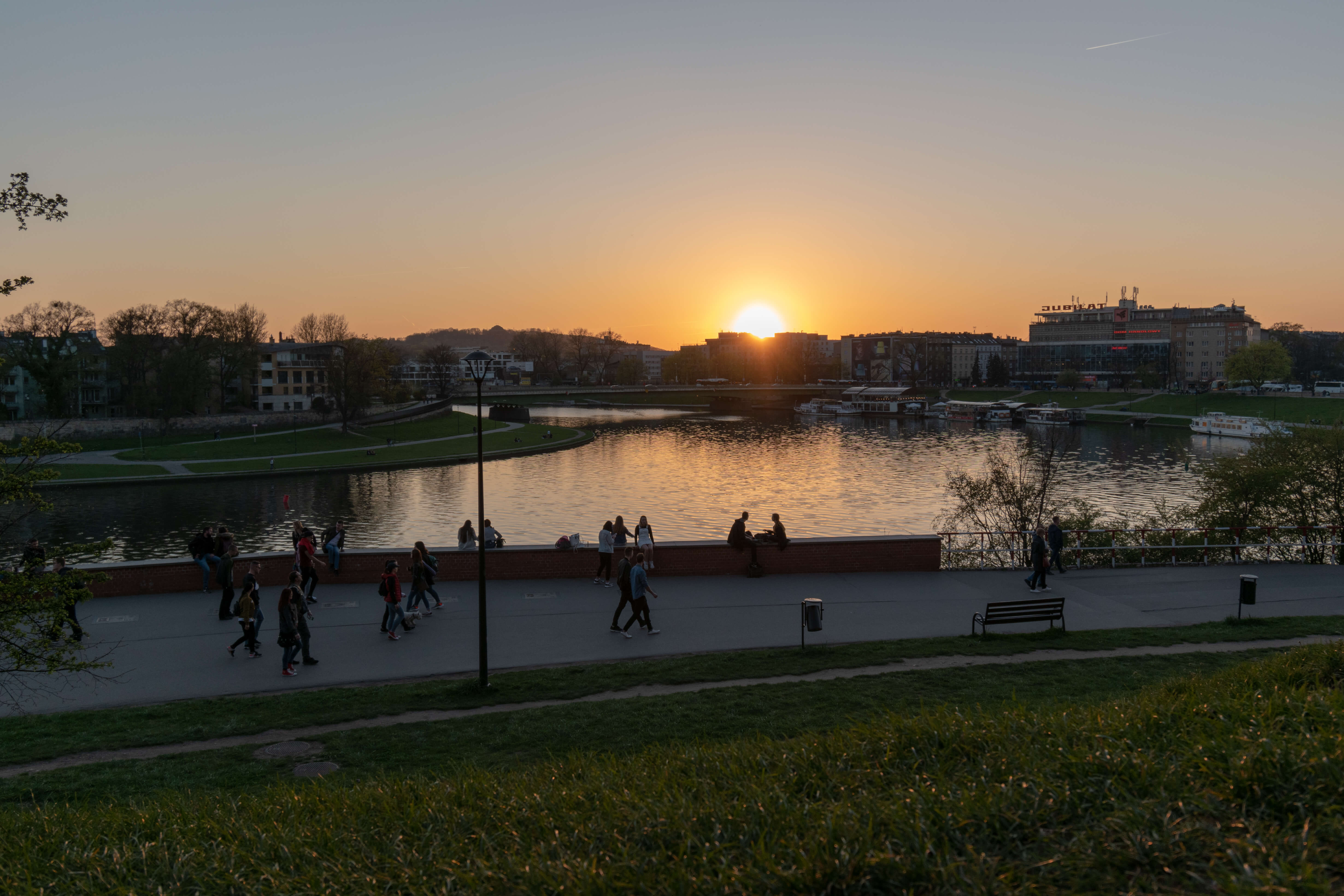
Saturday
It’s early Saturday morning as I walk north through some of Planty Park. Surrounding Stare Miasto (Old Town) is Planty Park. Planty Park stands where the old medieval walls stood in the 18th and early 19th centuries. It is four kilometers around and is a nice, easy walk. Along the shady paths are beautiful flowers, buildings, ponds, statues, and much more. There are plenty of park benches where you can sit and take in the views.
On almost every street corner you can find someone selling obwarzanek which is like a bagel or pretzel. There are several flavors like salt, poppy seed, sesame, etc. I try the sesame one and it’s quite good. At less than 25 cents, you can't beat it for a quick snack.
Before the main square gets busy, I find a bench to sit on and watch as the vendors begin to set up, the horses arrive, and kids feed pigeons. While I’m sitting, I see an elderly man to my left holding a green plastic bag full of birdseed. He begins to handout handfuls to bystanders and shows them how to have the pigeons land on you and eat from your hands. I’m intrigued. I walk over to the gentleman who graciously places a handful of seed in my hand. A few moments later, birds are landing on my arm and eating from my hand. It was a cool experience that I wasn’t planning to have.
One of the most recognizable icons in Kraków is the Sukiennice (Cloth Hall). Located in the main square, you can’t miss it. During the Renaissance period, it was a major market for international trade. Today, it isn’t significant on an international level but it is still filled with vendors selling a variety of things. On the second floor, there is now a museum. It’s been listed as a UNESCO World Heritage Site since 1978.
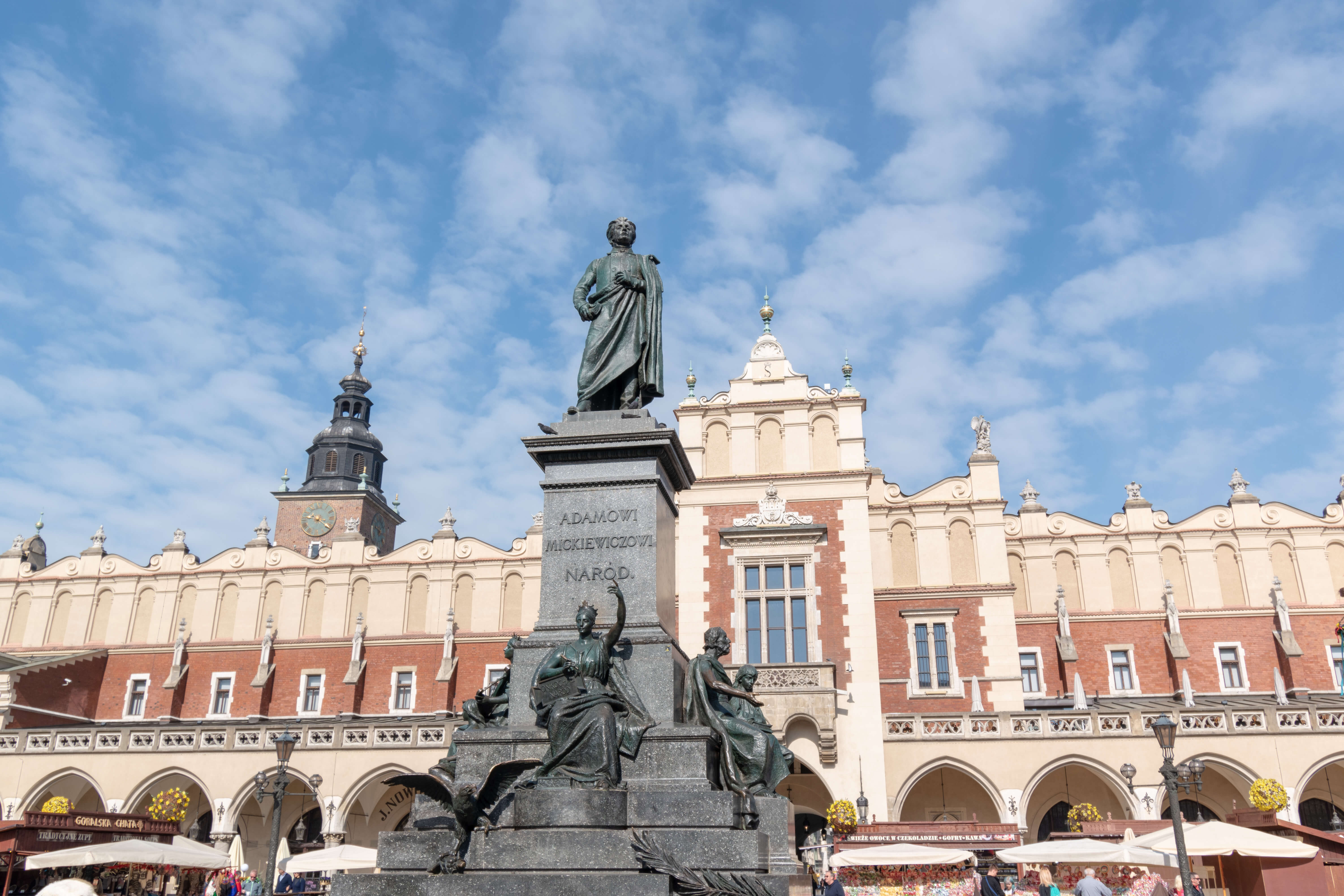
Four meters under central square is Rynek Underground museum. Completed in 2010, the museum gives a history of Kraków and displays recently discovered remnants of merchant stalls and various objects. Only 300 people are allowed in at a time so it is recommended to book online ahead of time. The entrances to the ticket office and the actual museum aren’t the easiest to find. The ticket office entrance is located on the west side of the Cloth Hall and the entrance to the museum is on the east side. I emerge from under the ground and am hungry for a snack. I haven’t tried any cheese yet so I get some goat cheese and jam. Wow! It is probably the best cheese I’ve ever had.
On Wielka Sobota (Holy Saturday), Polish households prepare Easter baskets with various food that will be eaten the next morning. The baskets are decorated with white cloths or lace, evergreens, flowers, etc. Typical items inside the baskets are salt, bread, sausage, butter, ham, candle, eggs, cheese, and bacon. Nowadays, chocolate is often included too. As I walk the streets on Saturday, I pass by countless families with their Easter baskets taking them to the church to get blessed. I loved seeing how important Easter still was in Poland and how another country and culture celebrate.
Southeast of Old Town, I find Schindler’s Factory. Oskar Schindler was a member of the German Nazi party but is credited with saving the lives of 1,200 Jews by hiring them to work at his factory. Something that caught my eye was the plaque you find on the outside of the factory in remembrance of Schindler was made in Michigan (Albion College).
From the factory, I make my way back over the river towards Kazimierz (the Jewish Quarter). Kazimierz was the hub of Jewish life in Kraków for hundreds of years prior to being destroyed and falling into disrepair during World War II. It wasn’t until the 1990’s that the district began to see a comeback. This is partly thanks to Steven Spielberg’s “Schindler’s List” placing a spotlight on it. Today, it is one of the liveliest districts in Kraków and holds great importance to Jews. Inside of Kazimierz is Plac Nowy (New Square) which for generations was referred to as “Jewish Square” by the locals. The square looks nothing like the main square. It’s not visually appealing and looks run down. The highlight of the square are the food stalls. If you look around the square, you will see most people are eating zapiekanka. Zapiekanka is half a baguette (or any other long bread), traditionally topped with white mushrooms and cheese, and toasted. Nowadays, there are more options and toppings that you can choose from. It’s said that the zapiekanka in Plac Nowy is the best in all of Poland, but I can neither confirm nor deny since it is the only zapiekanka I have had.
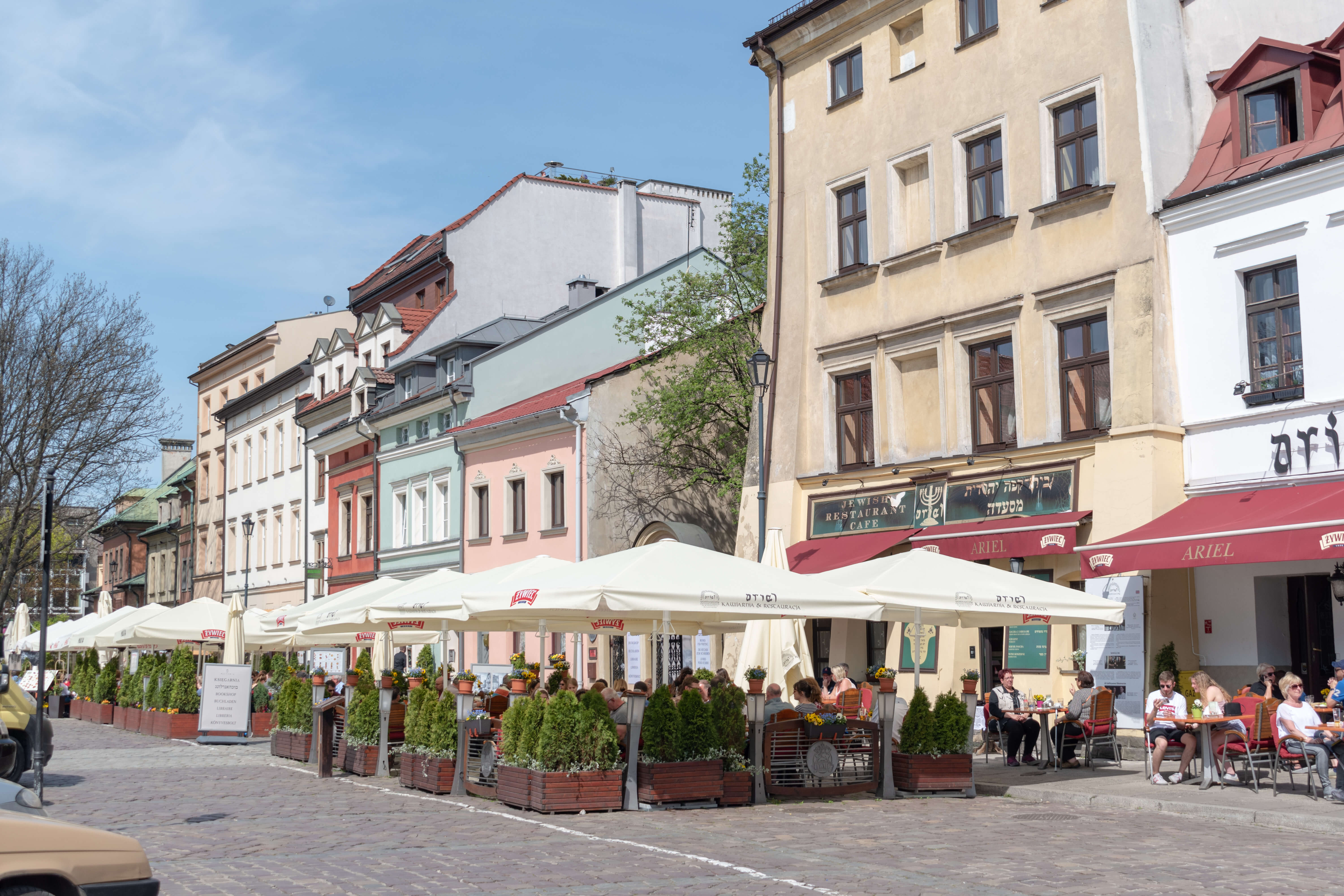
It's been a full day of exploring and as I’m walking back to the hostel I pass a bakery that I spotted earlier in the day. There is one last food on my list I need to try. A Polish food most people from the US know are pączkis, doughnuts with a filling typically sold prior to Easter. There are a wide variety of flavors, but I decide to try the traditional pączki as well as a chocolate one. I must say, they were both the best I have had. They feel lighter and less fattening than the ones in the US.

Easter Sunday
My alarm goes off on Easter and I venture back to the market. My bus doesn’t leave until midnight, so I have another full day. It has been a perfect 20° (68° F) and sunny all weekend so I sit and relax in the market for most of the morning. In the afternoon I go to Planty Park to escape the sun for a couple of hours. The rest of the evening is spent at the market and eating one last meal before heading back to Germany.
Kraków and Poland have far exceeded my expectations. Kraków is such a beautiful city rich in history, has plenty to do, and has amazing food. It's not too big, is a very walkable city, and has so many outdoor activities to offer. It has quickly become one of my favorite European cities.
